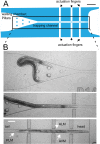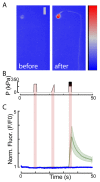Using a Microfluidics Device for Mechanical Stimulation and High Resolution Imaging of C. elegans
- PMID: 29553526
- PMCID: PMC5931315
- DOI: 10.3791/56530
Using a Microfluidics Device for Mechanical Stimulation and High Resolution Imaging of C. elegans
Abstract
One central goal of mechanobiology is to understand the reciprocal effect of mechanical stress on proteins and cells. Despite its importance, the influence of mechanical stress on cellular function is still poorly understood. In part, this knowledge gap exists because few tools enable simultaneous deformation of tissue and cells, imaging of cellular activity in live animals, and efficient restriction of motility in otherwise highly mobile model organisms, such as the nematode Caenorhabditis elegans. The small size of C. elegans makes them an excellent match to microfluidics-based research devices, and solutions for immobilization have been presented using microfluidic devices. Although these devices allow for high-resolution imaging, the animal is fully encased in polydimethylsiloxane (PDMS) and glass, limiting physical access for delivery of mechanical force or electrophysiological recordings. Recently, we created a device that integrates pneumatic actuators with a trapping design that is compatible with high-resolution fluorescence microscopy. The actuation channel is separated from the worm-trapping channel by a thin PDMS diaphragm. This diaphragm is deflected into the side of a worm by applying pressure from an external source. The device can target individual mechanosensitive neurons. The activation of these neurons is imaged at high-resolution with genetically-encoded calcium indicators. This article presents the general method using C. elegans strains expressing calcium-sensitive activity indicator (GCaMP6s) in their touch receptor neurons (TRNs). The method, however, is not limited to TRNs nor to calcium sensors as a probe, but can be expanded to other mechanically-sensitive cells or sensors.
Similar articles
-
Pneumatic stimulation of C. elegans mechanoreceptor neurons in a microfluidic trap.Lab Chip. 2017 Mar 14;17(6):1116-1127. doi: 10.1039/c6lc01165a. Lab Chip. 2017. PMID: 28207921 Free PMC article.
-
On-chip functional neuroimaging with mechanical stimulation in Caenorhabditis elegans larvae for studying development and neural circuits.Lab Chip. 2018 Feb 13;18(4):601-609. doi: 10.1039/c7lc01201b. Lab Chip. 2018. PMID: 29340386 Free PMC article.
-
Detecting and Trapping of a Single C. elegans Worm in a Microfluidic Chip for Automated Microplate Dispensing.SLAS Technol. 2017 Aug;22(4):431-436. doi: 10.1177/2211068216669688. Epub 2016 Sep 26. SLAS Technol. 2017. PMID: 27630097
-
Microfluidic Devices in Advanced Caenorhabditis elegans Research.Molecules. 2016 Aug 2;21(8):1006. doi: 10.3390/molecules21081006. Molecules. 2016. PMID: 27490525 Free PMC article. Review.
-
Microfluidic systems for high-throughput and high-content screening using the nematode Caenorhabditis elegans.Lab Chip. 2017 Nov 7;17(22):3736-3759. doi: 10.1039/c7lc00509a. Lab Chip. 2017. PMID: 28840220 Review.
Cited by
-
Touch-induced mechanical strain in somatosensory neurons is independent of extracellular matrix mutations in Caenorhabditis elegans.Mol Biol Cell. 2020 Jul 21;31(16):1735-1743. doi: 10.1091/mbc.E20-01-0049. Epub 2020 Jun 24. Mol Biol Cell. 2020. PMID: 32579427 Free PMC article.
-
Sexually dimorphic architecture and function of a mechanosensory circuit in C. elegans.Nat Commun. 2022 Nov 11;13(1):6825. doi: 10.1038/s41467-022-34661-3. Nat Commun. 2022. PMID: 36369281 Free PMC article.
-
Loss of CaMKI Function Disrupts Salt Aversive Learning in C. elegans.J Neurosci. 2018 Jul 4;38(27):6114-6129. doi: 10.1523/JNEUROSCI.1611-17.2018. Epub 2018 Jun 6. J Neurosci. 2018. PMID: 29875264 Free PMC article.
-
Sensory experience controls dendritic structure and behavior by distinct pathways involving degenerins.Elife. 2025 Jan 10;14:e83973. doi: 10.7554/eLife.83973. Elife. 2025. PMID: 39791349 Free PMC article.
-
Development of Microplatforms to Mimic the In Vivo Architecture of CNS and PNS Physiology and Their Diseases.Genes (Basel). 2018 Jun 6;9(6):285. doi: 10.3390/genes9060285. Genes (Basel). 2018. PMID: 29882823 Free PMC article. Review.
References
Publication types
MeSH terms
Grants and funding
LinkOut - more resources
Full Text Sources
Other Literature Sources
Miscellaneous





